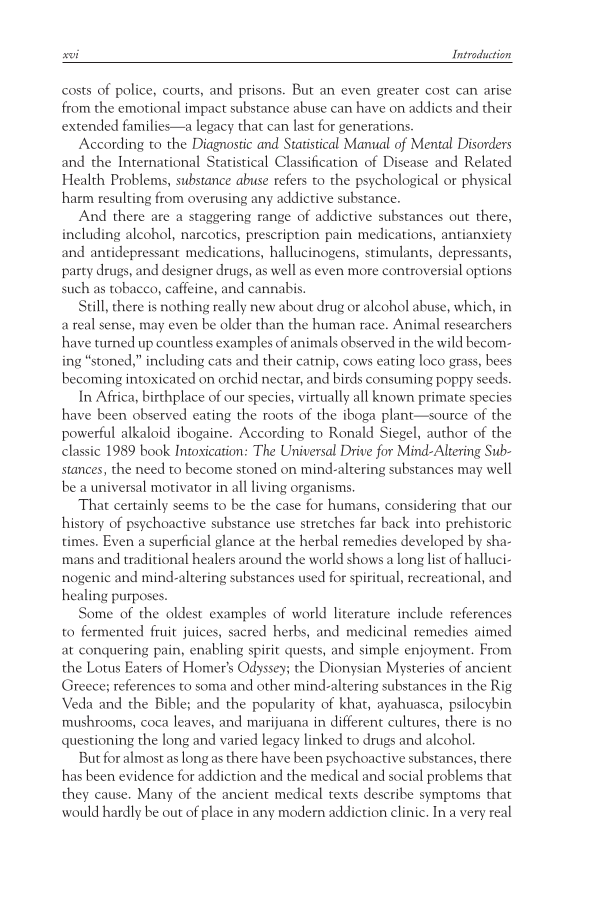xvi Introduction costs of police, courts, and prisons. But an even greater cost can arise from the emotional impact substance abuse can have on addicts and their extended families—a legacy that can last for generations. According to the Diagnostic and Statistical Manual of Mental Disorders and the International Statistical Classification of Disease and Related Health Problems, substance abuse refers to the psychological or physical harm resulting from overusing any addictive substance. And there are a staggering range of addictive substances out there, including alcohol, narcotics, prescription pain medications, antianxiety and antidepressant medications, hallucinogens, stimulants, depressants, party drugs, and designer drugs, as well as even more controversial options such as tobacco, caffeine, and cannabis. Still, there is nothing really new about drug or alcohol abuse, which, in a real sense, may even be older than the human race. Animal researchers have turned up countless examples of animals observed in the wild becom- ing “stoned,” including cats and their catnip, cows eating loco grass, bees becoming intoxicated on orchid nectar, and birds consuming poppy seeds. In Africa, birthplace of our species, virtually all known primate species have been observed eating the roots of the iboga plant—source of the powerful alkaloid ibogaine. According to Ronald Siegel, author of the classic 1989 book Intoxication: The Universal Drive for Mind-Altering Sub- stances, the need to become stoned on mind-altering substances may well be a universal motivator in all living organisms. That certainly seems to be the case for humans, considering that our history of psychoactive substance use stretches far back into prehistoric times. Even a superficial glance at the herbal remedies developed by sha- mans and traditional healers around the world shows a long list of halluci- nogenic and mind-altering substances used for spiritual, recreational, and healing purposes. Some of the oldest examples of world literature include references to fermented fruit juices, sacred herbs, and medicinal remedies aimed at conquering pain, enabling spirit quests, and simple enjoyment. From the Lotus Eaters of Homer’s Odyssey the Dionysian Mysteries of ancient Greece references to soma and other mind-altering substances in the Rig Veda and the Bible and the popularity of khat, ayahuasca, psilocybin mushrooms, coca leaves, and marijuana in different cultures, there is no questioning the long and varied legacy linked to drugs and alcohol. But for almost as long as there have been psychoactive substances, there has been evidence for addiction and the medical and social problems that they cause. Many of the ancient medical texts describe symptoms that would hardly be out of place in any modern addiction clinic. In a very real
Document Details My Account Print multiple pages
Print
You have printed 0 times in the last 24 hours.
Your print count will reset on at .
You may print 0 more time(s) before then.
You may print a maximum of 0 pages at a time.




















































































































































